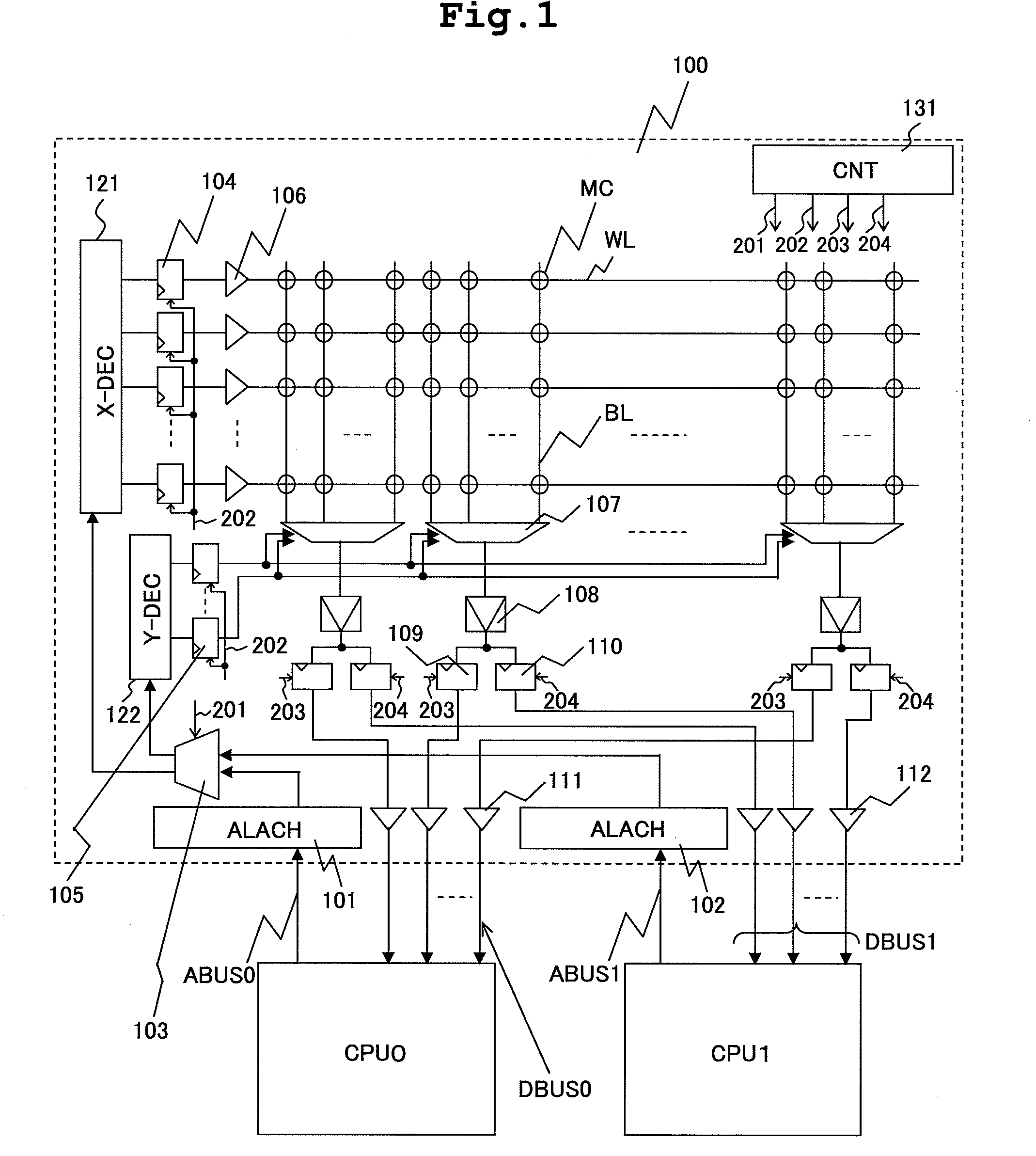Semiconductor integrated circuit device
- Summary
- Abstract
- Description
- Claims
- Application Information
AI Technical Summary
Benefits of technology
Problems solved by technology
Method used
Image
Examples
first embodiment
[0056]FIG. 18 shows a multi processor system, as an example of a semiconductor integrated circuit device in accordance with the invention.
[0057]Although no special restriction is intended, the multi processor system 10 shown in FIG. 18 is formed on a single semiconductor substrate, such as single crystal silicon substrate, by the well-known techniques of manufacturing semiconductor integrated circuits.
[0058]The multi processor system 10 shown in FIG. 18 has processors CPU0 and CPU1, an input / output (I / O) circuit 200 and a non-volatile semiconductor memory (MEM) 100 connected by a system bus BUS so that they can exchange signal with one another. However, no special restriction is intended with respect to this. The input / output circuit 200 is connected to two or more peripheral circuits (PER) 300 through a local bus 400. The peripheral circuits 300 include an A / D converter for converting an input analog signal into a digital signal, and a timer for measuring time. The non-volatile sem...
second embodiment
[0089]FIG. 3 shows an example of another structure of the multi processor system 10. The non-volatile semiconductor memory 100 shown in FIG. 3 differs from that shown in FIG. 1 significantly in that first-in first-out buffers (2-bit FIFO) 303 and 304 which take a 2-bit structure of address bus ABUS and data bus DBUS are provided. The operations of the 2-bit FIFOs 303 and 304 are controlled in accordance with a 2-bit FIFO trigger signal 401 produced by the control circuit 131.
[0090]The first embodiment requires that the read from the non-volatile semiconductor memory should meet the following condition expressed using the clock cycle TCLK defined as shown in FIG. 2 and the time lengths T1 to T3: T1+2T2+T3<TCLK”. However, the difference in speed between CPUs and memories tends to expand year by year in general. Therefore, it is difficult to meet the condition as described above except when a very high performance is not required and the CPUs' clocks are at most tens of megahertz.
[0091...
third embodiment
[0102]FIG. 5 shows an example of another structure of the multi processor system 10.
[0103]The multi processor system shown in FIG. 5 differs from that shown in FIG. 3 in that the read latency is improved by cache memories (CMEM) 501 and 502 disposed between the processors CPU0 and CPU1 and the non-volatile semiconductor memory 100.
[0104]The multi processor system in accordance with the second embodiment offers a sufficient throughput because an address can be accepted to output data every clock cycle. However, in the multi processor system, the read latency is 2TCLK, which has the effect of reducing the latency at the time of occurrence of read conflict between two CPUs by half, however cannot shorten the read latency per read to 1TCLK.
[0105]Hence, low-latency cache memories 501 and 502 are placed between the processors CPU0 and CPU1 and the non-volatile semiconductor memory 100 as shown in FIG. 5. The cache memories 501 and 502 each offer a latency of 1TCLK and have a performance t...
PUM
 Login to View More
Login to View More Abstract
Description
Claims
Application Information
 Login to View More
Login to View More - R&D
- Intellectual Property
- Life Sciences
- Materials
- Tech Scout
- Unparalleled Data Quality
- Higher Quality Content
- 60% Fewer Hallucinations
Browse by: Latest US Patents, China's latest patents, Technical Efficacy Thesaurus, Application Domain, Technology Topic, Popular Technical Reports.
© 2025 PatSnap. All rights reserved.Legal|Privacy policy|Modern Slavery Act Transparency Statement|Sitemap|About US| Contact US: help@patsnap.com



